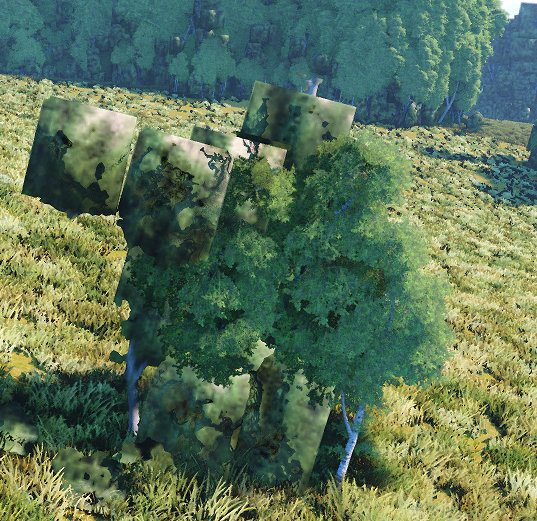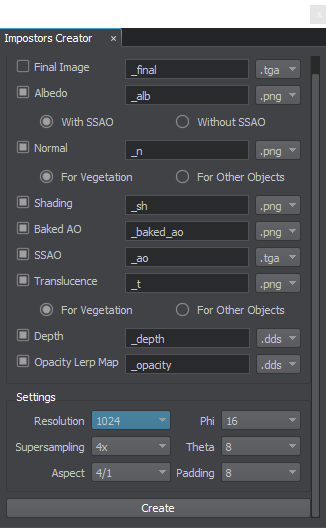Search the Community
Showing results for tags 'Vegetation'.
-
I've created impostors for grass and everything went ok but when i'm trying to create impostors for trees it gives me really strange result. I'm using trees from Vegetation pack. I attached the setting that I use to create impostors but changing them didn't help.
-
Hello, I'm trying to wrap my head around an actually efficient process to generate a large set of *various* trees and grass, in a very large terrain. Correct me if I'm wrong, but according to the doc, the process looks like: add a single tree of a single type in the scene create an impostor from it create an ObjectClutter from the tree *mesh* reassigns materials and readjust LOD distance for the clutter (so I'm actually redoing the work that was made when creating the tree *node*) create an ObjectGrass matching the ObjectClutter, manually inherit material, assign impostor texture, tweak LOD and other settings create a NodeReference for the ObjectClutter create a NodeReference for the ObjectGrass Now in Landscape editor, for a specific landcover tag, add the NodeReference for the ObjectClutter and then for the ObjectGrass Generate landscape Test, adjust ObjectClutter and ObjectGrass, apply updates, and repeat step 9 Repeat steps 1-10 for a new kind of tree While none of these steps is too complex, it's still very tedious if you want some diversity in your terrain. I feel the grass/impostors steps should really be a "behind the scene" operation. I tried using WorldClutter. Its usage seems more straightforward, and supports a variety of trees node by default, but I couldn't find a way to use it with grass impostors. For the records, I need a visibility distance of 5km at the very minimum with impostors. Real meshes only need to be visible below 100m.
-
Automatic impostors for landscape vegetation
Amerio.Stephane posted a topic in Feedback for UNIGINE team
Hello, Currently, after generating a landscape with vegetation, I must manually create the impostors for the trees, and then attach them in the scene. Could this be automated somewhat? Thank you- 6 replies
-
- vegetation
- impostors
-
(and 1 more)
Tagged with:
-
Hello, When creating a landcover vegetation, there is a strong mismatch with a tagged landcover. Worse, some generated clutter are empty. On the hereafter screencap, worldclutters were generated for the dark green area. WorldClutter_1 is on the left of the vertical line, and WorldClutter_3 is on the right. Only the _3 is filled. Attached is the test_project (I removed the core and bin folder for size consideration). Thanks for your help. test_project.7z
-
Hello, I'm using a landcover raster in my landscape, and I add vegetation on top of it. The landcover tag is created with a 0 threshold. A terrain detail layer is added on the same tag, shown hereafter with a red overlay. And vegetation is created with an ObjectGrass node. The problem here is I don't understand why the vegetation and the detail layer never match, whatever settings I put in the Mask of the detail layer: As you can see, there is grass in A but no grass in B. I would have expected the grass area outline to roughly match the red area (at least for a certain combination of threshold, width, contrast) but that is never the case ! Can you help me here? Thanks.
-
We currently have a scene which contains over 700 trees, in 10 varieties. Each tree has two levels of detail, the highest level consists of 2,500 tri's, while the lowest level has around 1k tri's. We have been placing the trees manually to ensure that they appear in the correct locations. Regarding CPU/GPU performance, is this the most efficient way to place vegetation, or would it be more suitable to use a mask within 'MeshClutter' to achieve a more stable frame-rate. Is there anything else that could be implemented to achieve a more stable frame-rate? Thanks
- 3 replies
-
- Vegetation
- Foliage
-
(and 5 more)
Tagged with:




